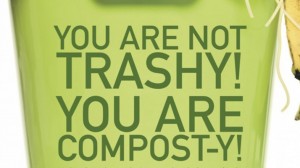 This semester, the UM Green Fund has provided funding to three campus projects including the expansion of the pilot composting program, which is projected to divert 36,000 pounds of pre-consumer food waste from the landfill during fall semester, and its first-ever initiatives targeting energy reduction.
This semester, the UM Green Fund has provided funding to three campus projects including the expansion of the pilot composting program, which is projected to divert 36,000 pounds of pre-consumer food waste from the landfill during fall semester, and its first-ever initiatives targeting energy reduction.
Composting Project Expansion
The pilot composting program began in the fall 2013 and has expanded for the fall 2014. The UM composting team now picks up pre-consumer food waste from Rebel Market, in addition to the Marketplace at the Residential Colleges. This food waste is then brought to the Medicinal Plant Garden to be composted.
The project is headed by Victoria Burgos, a junior Parks and Recreation Management major from Olive Branch, Mississippi, who originally proposed the project in the spring 2013. Burgos oversees the composting project with the help of two Green Student interns in the Office of Sustainability. In its first year, her project composted nearly 6,000 pounds of pre-consumer food waste from the RC Marketplace, creating 19 cubic yards of compost. That compost is now being used by the RC Garden Club to plant their new on-campus garden. The composting team is projected to compost up to 36,000 pounds of food waste this year.
To evaluate the project, Green Fund Committee faculty member Dr. Cristiane Surbeck’s civil engineering class (CE 471) completed an Environmental Impact Analysis. The class concluded that over one year the project reduced greenhouse gas (GHG) emissions of the RC Marketplace’s food waste by 1.25 equivalent kg of CO2 per pound of food waste composted. The net total of GHG emissions reduced was more than eight tons. The collaboration between the UM Green Fund and Dr. Surbeck’s class was a great opportunity to raise student awareness of environmental sustainability.
Energy Reduction Projects
The Green Fund has implemented its first-ever projects targeting energy reduction this fall. The projects, called the library window film project and the Flip-the-Switch project, will help to improve campus building efficiency, as well as engage students in energy conservation. The library window film project was proposed by J.D. Williams Library staff, and the Flip-the-Switch project was proposed by rising sophomore and UMGF Committee Member Joe Bell.
Library Window Film Project
Over the summer, low-e film was installed on the south-facing windows on the second and third floors of the J.D. Williams Library. The film will block up to 57 percent of solar energy, reducing the need for air conditioning to cool the room, which results in annual electricity cost savings between 5 and 15 percent.
The film also helps better protect the library’s archives and special collections in the Faulkner Room from UV light. UV rays can damage sensitive materials including historical books and letters like those found in the Faulkner Room. Pre-energy data and UV light measurements have been recorded and will be compared to data recorded after film installation to determine electricity and cost savings. Since the installation of the low-e film, the staff members on the second floor are now able to keep their blinds open and take advantage of the office view while still remaining comfortable.
Flip-the-Switch Project
The Residential Colleges house the Flip-the-Switch project, which is geared toward lowering energy use in the residence halls. The Flip-the-Switch project is an awareness campaign targeting behavior changes. For this project, stickers have been placed above the light switches in residence hall rooms at the RCs to remind students to turn out their lights when they leave.
The stickers are unique to each floor in RC South, so no two floors have the same sticker. The fourth floor of RC South has no sticker, and serves as the control floor. The energy data collected will reflect the effectiveness of different messages and styles of the stickers. The Luckyday Residential College has the same sticker on all floors. The Flip-the-Switch project could help cut back on energy costs as well as serve as a model for future behavior change projects.
Past Green Fund Projects
Hydration Stations
During the 2013-2014 academic year, the UM Green Fund funded the installation of three hydration stations on campus. These stations provide access to cool, filtered water and encourage the reuse of water bottles. To date, more than 84,967 water bottles have been refilled at the stations. They are located in Brevard, Faser and Holman. This project was proposed by Tristen Jackson, a graduate of the pharmacy school.
H2otty Toddy Water Bottles
The first project funded by the UM Green Fund was the H2otty Toddy water bottle project proposed by writing professor Milly West and her LIBA 102 writing class. The class wrote a proposal and received funding to sell reusable H2otty Toddy Water Bottles at the 2013 Sustainability Fair as a part of Green Week. The water bottles were sold to raise awareness of the waste created by non-reusable water bottles and to encourage the use of reusable water bottles. Water bottle sales totaled more than $2,000. The proceeds were put back into the Green Fund.
To learn more about the Green Fund, visit olemiss.edu/greenfund.